Top News
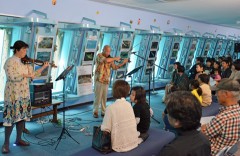
December 15, 2012 Ryukyu Shimpo
On December 9, at the Miyako Undersea Park Observation Facility, in Miyako-jima, the Japanese String Teachers Association (JASTA) held what was called “The Concert in the Sea.” This was a pre-event for the JASTA String Festival 2013, which will be held next March on Miyako-jima. Visitors enjoyed the classical music as they watched the fish swimming outside the windows.
Makoto Amano, the owner of a violin school and manager of JASTA Okinawa, played the viola and his wife played the violin. They performed Beethoven’s Minuet, Massenet’s Méditation, Miyako-jima’s folk song Tougani ayagu, Okinawan folk song Tinsa gunu no hana and other songs. The audience enjoyed the performance not only with their ears but also with their eyes, watching the fish lured closer by the music.
The JASTA String Festival 2013 will be held in Okinawa for the first time. Makoto Amano said, “The vitality of the children on Miyako-jima is impressive and they made good progress with only a little practice. We want people to see the children perform.” He also said, “We would like the festival to create a link with tourism to build momentum for inviting international music festivals to Miyako-jima.”
(English translation by T&CT, Hitomi Shinzato and Mark Ealey)
Go to Japanese
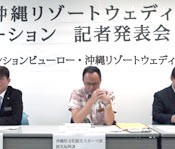
December 21, 2012 Ryukyu Shimpo
On December 20, the Okinawa Prefectural Government (OPG), the Okinawa
Convention & Visitors Bureau, and the Okinawa Resort Wedding Association announced an international promotion plan through which by 2015 they aim to attract one thousand resort wedding couples from abroad per year. To date, the OPG has carried out promotions overseas in conjunction with individual companies, but this is the first time that it will promote a tourism-related business in collaboration with the bridal industry as a whole. Through this project, the OPG hopes to increase awareness of Okinawa abroad, carrying out promotions to let people know about the attractive aspects of a family trip to the prefecture.
The target of the project in the initial fiscal year, which ends on March 31, 2013, is tourists from Taiwan, Hong Kong and South Korea, countries and regions where direct flights from Okinawa exist and for which there are no visa restrictions. They will participate in overseas resort wedding bridal fairs held in various regions from January next year, and will monitor the resort wedding business abroad.
According to the Tourism Promotion Division of the OPG, the total number of resort weddings held in 2011 in Okinawa was 8872 couples (8616 from Japan and 256 from overseas). That produced an economic benefit of 15.4 billion yen that year. A total of 204 couples came to Okinawa from foreign countries in the period from January to June in 2012.
In order to expand the business in the future, they would particularly like to strengthen efforts to attract tourists from abroad. This project has been carried out as a part of the OPG’s “Visit Okinawa Plan.” Tourism-related industries will contribute approximately 29 million yen of the total project cost of about 97 million yen. At a press conference held on December 20 at the Urasoe City Industrial Promotion Center, Shigenobu Asato, the chairperson of the Okinawa Convention & Visitors Bureau, said, “Following on from this project, we would like to expand our efforts to attract tourists from overseas in a variety of ways based on the understanding from the people of Okinawa towards the resort wedding business.”
(English translation by T&CT, Mark Ealey)
Go to Japanese

December 20, 2012 Ryukyu Shimpo
On December 15, a mongoose was seen to cross the street at the Gusuku intersection in Nago. When the light turned green, the mongoose slowly started to cross while looking both ways for oncoming cars. The animal succeeded in crossing the road.
Some elementary school students waiting for the traffic light to change were surprised and impressed to see the mongoose carefully cross the street.
Masamichi Fujine of the Ark Okimaru, who rears animals at the Okinawa Zoo & Museum, said, “The mongoose is a very cautious animal, but it is adaptable and will make its den near where it finds food and hiding places.”
Go to Japanese
December 19, 2012 Ryukyu Shimpo
En Group, which runs restaurants and a wholesale business based in Asia, is considering increasing its exports of Okinawan brown sugar to Hong Kong more than ten times from about 35 tons to 400 tons. This is the equivalent of almost five percent of the 2012 to 2013 production in Okinawa. They are planning to sell wholesale to sugar companies in Hong Kong, including Taikoo Sugar. In January 2013, Taikoo Sugar will send senior staff to Okinawa to look at sugar factories and processors.
The general manager of Okinawa Central Trading, Naoki Aguni, who is in charge of the trading division of En Group, said that distributing 400 tons of brown sugar will lead to the introduction of regular shipping services to Hong Kong and will help promote the name and products of Okinawa.
According to the president of En Group Mayumi Matayoshi, Taikoo Sugar is a major company that sells sugar not only in Hong Kong, but also to mainland China, Taiwan and Singapore. En Group has already exported more than 35 tons of processed brown sugar to the company.
On this occasion, Taikoo Sugar required 400 tons of pure brown sugar, which is more fragrant, for Hong Kong. Depending on future demand, they are hoping to develop markets other than Hong Kong. According to the Japan Agricultural Co-operatives Okinawa, Okinawan brown sugar has been produced at sugar factories on eight remote islands such as Iheya-jima, Tarama-jima and Iriomote-jima. Production of brown sugar during 2011 and 2012 decreased to 40918 tons because of the effects of typhoons, disease and insects. In the period between 2012 and 2013 it is expected to be around 7000-8000 tons.
(English translation by T&CT, Lima Tokumori and Mark Ealey)
Go to Japanese
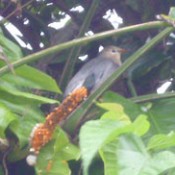
December 18, 2012 Ryota Nakamura of the Ryukyu Shimpo
Three sixth-grade pupils of Kijoka Elementary School in Ogimi Village have filmed a red-billed starling. The school has conducted bird-watching in the area since 1988.
Red-billed starlings are rarely seen in Kijoka. In fact, almost no sightings of the bird exist, either by the school or by Toyoko Ichida, a member of the Yambaru no Mori Trust who teaches bird-watching at the school.

On December 5, at Kijoka Elementary School in Ogimi, Kotomi Kuniyoshi, Hiyori Taira, and Maya Shimabukuro (from left) found a red-billed starling.
On November 22, three sixth-grade students, Hiyori Taira, Maya Shimabukuro and Kotomi Kuniyoshi found a red-billed starling behind a tree on their way home from school. Taira, who took a picture of the bird, said, “It was a bird that I had never seen before. I like observing what is happening in the rice fields and the waterfowl there.”
Sixth-grade class teacher Harue Yamashiro said, “I think it is important for them to recognize things that they do not know about, and to study about birds they have never seen.”
(English translation by T&CT, Megumi Chibana and Mark Ealey)
Go to Japanese
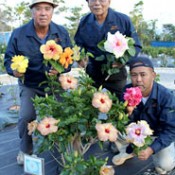
December 19, 2012, Ryukyu Shimpo
This December, the Yaka Farm Shop, in Yaka, Kin Town, opened selling more than 250 different varieties of hibiscus from all around the globe. An array of colorful flowers welcome the customers to the shop, which is a joint project run by the owner, Takashi Gushiken, and his former teacher Masatetsu Nakama who taught him at Hokubu Agricultural High School.
Visitors to the shop can enjoy over 250 different varieties of hibiscus, 90 types of croton plants as well as 60 kinds of subtropical fruit trees. Opening the farm shop was Gushiken’s idea, something he had dreamed of doing for decades. He has worked in the landscape business and has been looking for ways to help vitalize the community by making the most of what nature offers.
The farm has a great view. From the bottom of the farm, Kin Bay expands out to the horizon, and if you look up the mountainside you can enjoy a view of the subtropical fruit trees with Mount Yaka in the background. The tree in the middle of the farm is a 50 year-old cork tree that Gushiken planted 30 years ago for this very occasion.
“I always wanted to have my own farm,” said Gushiken. After retiring, he visited Hawaii and Malaysia to learn more about hibiscus. The impact of the previous typhoons was considerable and has an adverse effect on the plantation, but Gushiken says, “This is also a part of nature. At some stage typhoons will work to our advantage.” His son Tatsuya also helps the farm.
Nakama said, “The flowering trees are still in the growing stage, but I enjoy seeing how they grow and blossom.” Gushiken also commented, “We welcome visitors to the farm to see how the flowers are blossoming in this beautiful environment.”
The farm is open from 9:00am to 6:00pm. Yaka Interchange is the nearest exit of the Okinawa Expressway. From there, head towards Onna on Route 88 and turn right before the Yaka Tunnel. High-school students and adults are asked to pay a 300 yen contribution as an entrance fee.
(English translation by T&CT, Kyoko Tadaoka and Mark Ealey)
Go to Japanese
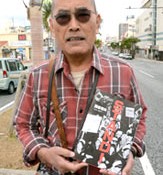
December 20, 2012 Ryukyu Shimpo
On the occasion of the 42nd anniversary of the Koza Riot, which occurred before dawn on December 20, 1970, 66 year-old former Ryukyu Shimpo cameraman Kazuo Kuniyoshi published a photo book entitled STAND! He has been taking photographs of the U.S. military bases in Okinawa and the people living around them.
The book features 189 black-and-white photographs including scenes from the Koza Riot, the intensifying military exercises by U.S. forces despite Okinawa’s reversion from U.S. rule to Japanese sovereignty, and the Osprey protest rally held in 2012. These photographs graphically depict the reality of U.S. military bases and Okinawa.
Kuniyoshi had only been with the Ryukyu Shimpo for six months when the riot occurred. He remembers standing in front of burning cars and a frenzied crowd, smelling burning rubber as he took his photographs.
Since then Kuniyoshi has captured images of the U.S. military at close range such as photographs of muddied marines engaged in training and scenes from the U.S. and South Korea military exercise. Kuniyoshi has also taken photographs of local residents living beside the bases and the people protesting against unreasonable oppression.
Kuniyoshi said, “The lives of the Okinawan people have changed and they have become more affluent, but the U.S. military bases still remain. I want the people living in the main islands of Japan, who force the bases on Okinawa but then ignore the resulting situation, to think about the base issues.”
The book has 312 pages and sells for 2500 yen.
For further details, call Photogenic Person’s Peace at 098-963-6488.
Go to Japanese
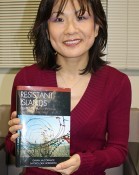
December 16, 2012 Michiyo Yonamine of the Ryukyu Shimpo
A book called Resistant Islands, which looks at the issue of U.S. military bases from the viewpoint of local residents, was published in the United States this summer. Satoko Norimatsu, the director of the Peace Philosophy Centre, an organization promoting peace, and Gavan McCormack, the representative editor of the Japan Focus, an online journal that publishes articles about the Asia-Pacific region, co-wrote the book. While Norimatsu lives in Canada and McCormack in Australia, they continue to convey to the outside world information about the adverse situation that Okinawa faces. Norimatsu talked about the book during a visit to Okinawa, saying, “There are very few books written in English about the Futenma relocation issue from the viewpoint of Okinawan people. I want people overseas to know about the situation that Okinawa faces.”
Norimatsu, who is from Tokyo but now lives overseas, became interested in Okinawa in 2006. When she participated in the World Peace Forum held in Canada, a man from Okinawa raised his hand in a question and answer session. While the facilitator told him to hurry up and finish in one minute, he refused to do so, saying, “I cannot complete what there is to say about Okinawa in such a short time.” It was an awkward moment, but Norimatsu said, “I didn’t know much about Okinawa at that time. What the man said really stayed in my head.”
After the Democratic Party of Japan became the ruling party in 2009 the overseas media started to give frequent news coverage of U.S. Marine Corps Air Station Futenma. Seeing former mayor of Ginowan Yoichi Iha push hard for the relocation of the U.S. Marine Corps in Okinawa overseas on the web, Norimatsu thought that information about Okinawa should be conveyed to the world in English because only Japanese could access the information available in the Japanese language.
Norimatsu negotiated with the Japan Focus, with whom she had not had any previous contact, and published articles about Okinawa that were translated in English on the Japan Focus website.
Since then, Norimatsu has been publishing news about Okinawa on the web. Every time she visits Okinawa, she goes around the bases and battle sites, deepening her friendships with Okinawan people. However, feeling that people overseas have little opportunity to hear the voices of the Okinawan people, Norimatsu thought that she should convey Okinawa’s struggles to the world, and so she decided to publish the book in 2010.
With regard to her two year-writing project, Norimatsu said, “I realized how insincere my previous peace movement was.” Norimatsu later found out that the man who spoke at the forum in 2006 was Teruo Onishi, who belongs to the Council Opposing the Helicopter Base. Norimatsu said, “I now understand why Onishi-san was so angry. You cannot be properly engaged in a peace movement without knowing about Okinawa. I want to devote the rest of my life to the Okinawan cause because I had not done any work for Okinawa before.” Norimatsu intends to continue conveying Okinawa’s voice to the world.
(English translation by T&CT, Mark Ealey)
Go to Japanese

December 14, 2012 Ryukyu Shimpo
On December 13, the Okinawa Film Office of the Okinawa Convention and Visitors Bureau (OCVB) reported that they had invited a Taiwanese drama and successfully finished the filming.
From December 4 to 11, a Taiwanese television drama entitled How Is Marriage? was filmed at a chapel in Yomitan and at the Nakagusuku Castle Ruins in Nakagusuku Village, as well as other locations in Okinawa. Taiwan Next TV will broadcast it in May 2013.
Popular actress Tien Hsin who received Taiwan’s 2011 Best Lead Actress Award, appears in the drama. With “marriage” as its theme, it depicts stories of families, couples, love, and emotions. It was shot on locations at a beautiful beach and in a resort hotel.
To promote Okinawa internationally, the OCVB started the Overseas Contents Support Project and provided financial assistance to help film images that will be broadcast overseas.
In the 2012 fiscal year, the OCVB provided assistance of up to 30 million yen for six films. This Taiwanese drama is the fourth project and was granted 22 million yen.
(English translation by T&CT, Megumi Chibana and Mark Ealey)
Go to Japanese
December 11, 2012 Ryukyu Shimpo
On December 10, at Miyako-jima Municipal Office in Hirara, Seok-Je Kim, the Okinawa branch manager of Asiana Airlines, visited Mayor Toshihiko Shimoji and reported that they will operate charter flights between Miyako and Seoul on February 8 and 10, 2013. The airline has previously operated flights between Naha and Seoul.
They expect that about 170 people will visit the island on the three-day, two-night trip put together by the Korean company Lotte Tour. They will use an Airbus 321 aircraft.
Seon-Yong Lee, the deputy manager of Lotte Tour, said that they thought that Miyako-jima is small but has many places to see. If Korean people come to know about its attractions, then the number of visitors will increase.
Kim said they would like the municipal office to cooperate in promoting tourist traffic between Seoul and Okinawa.
Mayor Shimoji welcomed Kim and promised to cooperate with regard to the immigration procedures.
(English translation by T&CT, Lima Tokumori and Mark Ealey)
Go to Japanese
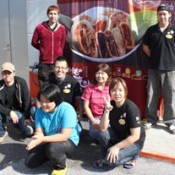
December 7, 2012 Ryukyu Shimpo
The Japan Local Products Exhibition run by the Central Federation of Commerce and Industry was held in Tokyo between November 23 and 25. Okinawa-no-Maruyaki, a food item produced by Makoto Mochi in Motobu, represented Okinawa, and won the fifth prize. Makoto Higa, the owner of the company, said, “I am confident about Okinawa-no-Maruyaki. It is right up there at national level in terms of its taste.” Awards were made after voting by the participants and as many as 3000 Okinawa-no-Maruyaki were sold in the three days.
Okinawa-no-Maruyaki was produced with the support of the Okinawa Prefectural Government in 2012. Makoto-Mochi commenced sales in May, with the price pitched at 550 yen for three pieces. It uses tacos-type cheese, rafute (pork with soy sauce), purple yam and other Okinawan daily items and sweets made into a paste form and wrapped in a batter made of rice flour. Unlike the Nagano Prefecture oyaki (Japanese dumpling with bean paste), which uses wheat flour or buckwheat flour, this new-product stays true to the original idea of mochi (rice cake).
Higa uses existing equipment to make Okinawa-no-Maruyaki. He distributes the product to stores as well as selling online, and is now talking with retail stores in Okinawa and other prefectures. He said, “The basic concept of the product is to wrap Ryukyuan dishes up together. There are three ways to eat it: fried, toasted or just heated up. We want people to know more about it, and for it to become a regular afternoon snack in Okinawa.” The Makoto Mochi website is http://www.makoto-mochi.jp/
(English translation by T&CT, Hitomi Shinzato and Mark Ealey)
Go to Japanese










 Webcam(Kokusai Street)
Webcam(Kokusai Street)


